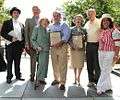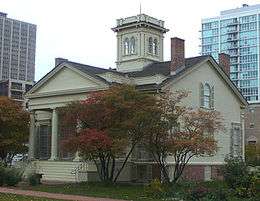Prairie District Neighborhood Alliance
|
The PDNA represents The Prairie Avenue Historic District
Pictured: John G. Glessner House, 1800 South Prairie Avenue | |
| Formation | 2006 |
|---|---|
The Prairie District Neighborhood Alliance (PDNA) is a non-profit resident organization in the South Loop community of Chicago, Illinois. The PDNA, founded in 2006, has grown to provide support and representation to thousands of residents living in and around the Prairie Avenue Historic District, Central Station and Museum Park, south Michigan Avenue corridor, and the broader South Loop. An area regarded as the fastest growing neighborhood in Chicago and one of the hottest neighborhoods in the country.[1] Basic Members receive free email updates and newsletters on community events; development news; educational, historical and cultural programs; select surveys and other important community news and information. The PDNA provides additional membership programs[2] offering support and benefits to residents, condominium/townhome associations, businesses, cultural institutions and organizations who reside within the Organization's boundaries and who agrees to and supports the purpose of the Alliance.[3]
Mission and Purpose
The Prairie District Neighborhood Alliance is a community organization whose mission is to build a sense of community and to promote the common good and social welfare for the South Loop area in Chicago. Also, to preserve the integrity of the neighborhood’s historic character and educate the public about its history. Further, to address issues of the neighborhood and provide it with an effective and transparent communication link with city municipal and government officials, developers, businesses and other influential groups, and to empower the community to work together in improving the neighborhood with the objective of fostering a collective, respectful and unified voice that translates into a powerful and influential force for improving and maintaining the community.
The purpose of the Prairie District Neighborhood Alliance is to provide an environment to meet neighbors, exchange ideas, prioritize projects, propose solutions, and implement plans for the neighborhood. The Neighborhood Alliance is concerned with issues that affect the quality of life in the community. Issues such as: education and schools, proposed residential and commercial development, zoning regulations, traffic and infrastructure improvements, as well as social activities and events that will strengthen the neighborhood. Additionally, the PDNA is committed to developing, facilitating, seeking community input, organizing, and delivering a variety of comprehensive community surveys, and/or an assortment of community projects and programs such as neighborhood festivals, block parties, seasonal celebrations, crime prevention activities, historical and educational programs and beautification plans for upgrading neighborhood parks.
 Pictured from left to right: Glessner House Executive Director, William Tyre; Alderman Robert Fioretti; Chicago Architecture Foundation Founding Executive Director, Jeanette Fields; Mayor Richard M. Daley; Chicago Architecture Foundation 1978 Festival Director, Marian Premer; Artist Jack Simmerling, and PDNA President, Tina Feldstein at The Festival on Prairie Avenue September 6, 2008
Pictured from left to right: Glessner House Executive Director, William Tyre; Alderman Robert Fioretti; Chicago Architecture Foundation Founding Executive Director, Jeanette Fields; Mayor Richard M. Daley; Chicago Architecture Foundation 1978 Festival Director, Marian Premer; Artist Jack Simmerling, and PDNA President, Tina Feldstein at The Festival on Prairie Avenue September 6, 2008 Pictured: The Henry B. Clarke House, architect unknown, is located at 1827 S. Indiana Avenue, Chicago, Illinois. Built in 1836 and untouched by the great Chicago fire of 1871, the Clarke House is Chicago’s oldest house and a classic example of the Greek Revival style. Moved twice and opened as a house museum in 1982, it features 19th century furnishings depicting life on the urban frontier. Designated a Chicago Landmark on October 14, 1970
Pictured: The Henry B. Clarke House, architect unknown, is located at 1827 S. Indiana Avenue, Chicago, Illinois. Built in 1836 and untouched by the great Chicago fire of 1871, the Clarke House is Chicago’s oldest house and a classic example of the Greek Revival style. Moved twice and opened as a house museum in 1982, it features 19th century furnishings depicting life on the urban frontier. Designated a Chicago Landmark on October 14, 1970- Pictured: The John J. Glessner House, operated as the Glessner House Museum, is an important 19th-century residence located at 1800 S. Prairie Avenue, Chicago, Illinois. It was designed in 1885-1886 by architect Henry Hobson Richardson and completed in late 1887. The property was designated a Chicago Landmark on October 14, 1970. The Glessner House is a key Prairie District Neighborhood Alliance partner.
Accomplishments
The Prairie District Neighborhood Alliance is concerned with issues that affect the quality of life in the community. Issues such as proposed residential and commercial development,[4] zoning regulations, environmental, traffic and infrastructure improvements, as well as events that will strengthen the neighborhood. The PDNA objective is to sponsor a variety of projects such as neighborhood festivals, block parties, town hall meetings, crime prevention activities and upgrading neighborhood parks.
With such rapid growth in the South Loop, residents who live within the Prairie District Neighborhood Alliance boundaries have become increasingly concerned[5] about the quality of new development[6] and the quality of work performed on properties converted[7] to residential use. Condo boards and residents have begun to band together to make their voices heard. Some have already achieved high-profile status. Additionally, the Prairie District Neighborhood Alliance and area residents work with the Alderman to actively review proposed[8] development projects in an effort to encourage smart growth and to protect[9] the architectural character[10] of the Historic Prairie Avenue District seeking to be respectful of important nearby structures such as the Landmark Glessner House Museum and Clarke House Museum.
On September 6, 2008, Alderman Robert Fioretti presented The Prairie District Neighborhood Alliance with a City Council resolution declaring September 6 as 'Prairie Avenue Day'. The City Council Resolution was presented to the PDNA at The Festival on Prairie Avenue, Mayor Richard M. Daley was in attendance during this significant moment. The Festival on Prairie Avenue,[11] which took visitors back to the time of the 1893 World’s Columbian Exposition in recognition of the street's restoration to its 1890s appearance, was attended by over 1,200 residents. At the festival, the PDNA honored[12] Mayor Richard J. Daley for his role in creating 'The Prairie Avenue Historic District', the first Historic District in Chicago. Current Chicago Mayor (and neighbor) Richard M. Daley attended the festival and accepted the honor on behalf of his father.
The Prairie District Neighborhood Alliance and its residents banned together[13] to successfully save the Vietnam Veterans Art Museum building at 1801 S. Indiana Avenue,[14] a cultural pillar of the neighborhood, from being sold privately and converted into a night club.[15] Instead, the building was purchased by the city of Chicago and conveyed to the Chicago Park District[16] to become a new Community Center.[17] The PDNA presented recommendations[18] to the Commission on Chicago Parks and the Alderman to name an important[19] new park which is located near 18th and Calumet Avenue, the site which marks the 1812 Fort Dearborn Massacre. On August 15, 2009 (the anniversary of the battle) the PDNA joined with the Alderman, Chicago Park District officials, Historians, Native Americans, Illinois Armory National Guardsman, Battle Descendants and a large number of community residents to commemorate and officially name the site as the Battle of Fort Dearborn Park and unveil an historic marker outlining the site's significance.[20] The PDNA is also focusing on the development of other highly anticipated neighborhood parks.
On January 27, 2010 the Prairie District Neighborhood Alliance introduced the South Loop Neighborhood Watch with the support of the 1st District police and 2nd Ward Alderman, Robert Fioretti. Additionally, the South Loop Neighborhood Watch Google Group was launched. This important communication tool allows the neighborhood to share BEAT 133 crime alerts, tips, or suspicious activity of value to the community. Beat 133 compromises the Prairie District neighborhood, the Central Station and Museum Park neighborhood and the South Michigan Avenue Corridor.
By aligning with the Alderman, businesses, cultural institutions and other like-minded organizations, the PDNA and its residents aim to bring much needed infrastructure and retail[21] to the area.
Architecture
The Architecture within the boundaries of the Prairie District Neighborhood Alliance represents every major building period in the history of Chicago, from the 1836 Greek Revival Clarke House (now a museum) to modern townhouse and condominium developments. Many of Chicago’s most important architects designed buildings here, including surviving examples by Daniel Burnham, Cobb and Frost, Solon Spencer Beman, Howard Van Doren Shaw, and Alfred Alschuler. Henry Hobson Richardson, a Boston architect, designed the Glessner House, a fully furnished house museum considered one of the most significant residential designs of the 19th century. A variety of architectural tours are available throughout the year, showcasing both the neighborhood as a whole, and specific buildings that have been preserved as house museums. More than two dozen buildings and sites, including mansions, industrial buildings, Motor Row District showrooms, and more, can be seen by walking through the area.
References
- ↑ "South Loop Rising, Faces of the South Loop" Chicago Magazine, June 2007.
- ↑ Membership
- ↑ "South Loop strives for identity as a new neighborhood evolves" New Homes Magazine, October 24, 2007.
- ↑ "South Loop meetings discuss area events, developments" New West Gazette, July 6, 2007.
- ↑ "The perfect shock" Chicago Sun Times, February 16, 2007.
- ↑ "Proposed zoning change threatens South Loop project" Crain's Chicago Business, July 20, 2007.
- ↑ "I don't know. Why are you bothering me?" Chicago Sun Times, February 16, 2007.
- ↑ "PDNA wants X/O investigation: planning department refuses" New West Gazette, April 3, 2007.
- ↑ "Haithcock promises to stall X/O, again" Chicago Journal, March 7, 2007.
- ↑ "Pie in the sky" Chicago Journal, January 21, 2007.
- ↑ "Oddball on the wrecking crew" Chicago Journal, September 3, 2008.
- ↑ "1890s revival at Festival on Prairie Avenue" New West Gazette, August 2008.
- ↑ "Park District acquires South Loop property" Chicago Journal, November 21, 2007
- ↑ "Park District gains property" New West Gazette, August 2008.
- ↑ "Vets Museum goes to Park District" Chicago Journal, June 27, 2007.
- ↑ "Party in a war zone" Chicago Reader, March 3, 2007.
- ↑ "Cafe Society rumbles" Chicago Journal, February 14, 2007.
- ↑ "Park likely to be named for Black Partridge" New West Gazette, August 2007.
- ↑ "Renaming: Black Partridge Park?" Chicago Journal, May 24, 2007.
- ↑ "Blood on the ground" Chicago Reader, March 23, 2007.
- ↑ "Density envisioned around future el stops", Chicago Journal, November 19, 2008.
External links
- Prairie District Neighborhood Alliance
- South Loop Neighborhood Watch
- Clarke House Museum
- Glessner House Museum
- Friends of Historic Second Church